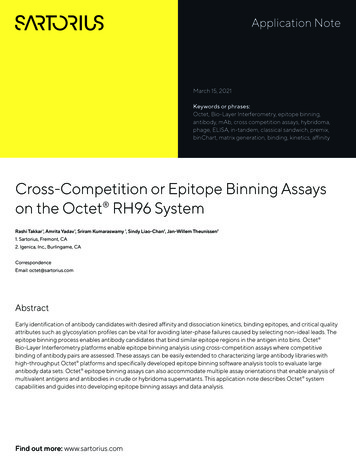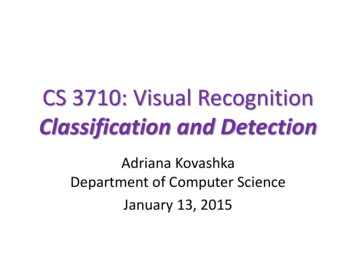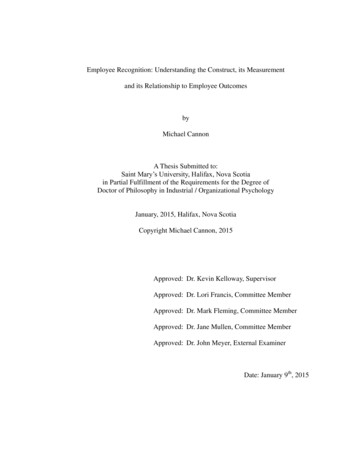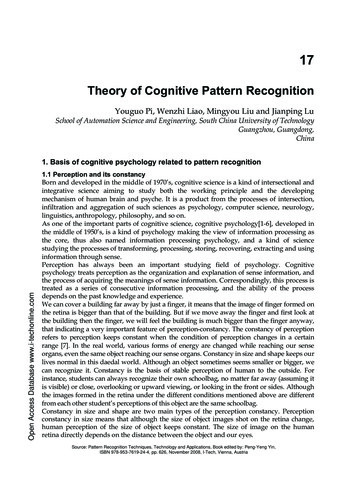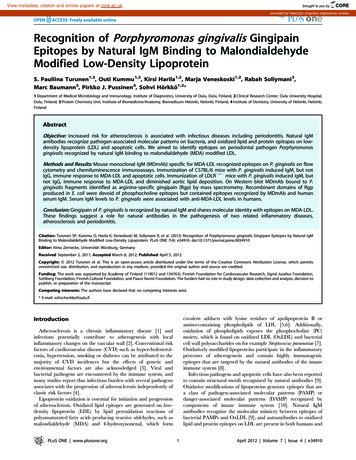
Transcription
View metadata, citation and similar papers at core.ac.ukbrought to you byCOREprovided by Helsingin yliopiston digitaalinen arkistoRecognition of Porphyromonas gingivalis GingipainEpitopes by Natural IgM Binding to MalondialdehydeModified Low-Density LipoproteinS. Pauliina Turunen1,2, Outi Kummu1,2, Kirsi Harila1,2, Marja Veneskoski1,2, Rabah Soliymani3,Marc Baumann3, Pirkko J. Pussinen4, Sohvi Hörkkö1,2*1 Department of Medical Microbiology and Immunology, Institute of Diagnostics, University of Oulu, Oulu, Finland, 2 Clinical Research Center, Oulu University Hospital,Oulu, Finland, 3 Protein Chemistry Unit, Institute of Biomedicine/Anatomy, Biomedicum Helsinki, Helsinki, Finland, 4 Institute of Dentistry, University of Helsinki, Helsinki,FinlandAbstractObjective: Increased risk for atherosclerosis is associated with infectious diseases including periodontitis. Natural IgMantibodies recognize pathogen-associated molecular patterns on bacteria, and oxidized lipid and protein epitopes on lowdensity lipoprotein (LDL) and apoptotic cells. We aimed to identify epitopes on periodontal pathogen Porphyromonasgingivalis recognized by natural IgM binding to malondialdehyde (MDA) modified LDL.Methods and Results: Mouse monoclonal IgM (MDmAb) specific for MDA-LDL recognized epitopes on P. gingivalis on flowcytometry and chemiluminescence immunoassays. Immunization of C57BL/6 mice with P. gingivalis induced IgM, but notIgG, immune response to MDA-LDL and apoptotic cells. Immunization of LDLR2/2 mice with P. gingivalis induced IgM, butnot IgG, immune response to MDA-LDL and diminished aortic lipid deposition. On Western blot MDmAb bound to P.gingivalis fragments identified as arginine-specific gingipain (Rgp) by mass spectrometry. Recombinant domains of Rgpproduced in E. coli were devoid of phosphocholine epitopes but contained epitopes recognized by MDmAb and humanserum IgM. Serum IgM levels to P. gingivalis were associated with anti-MDA-LDL levels in humans.Conclusion: Gingipain of P. gingivalis is recognized by natural IgM and shares molecular identity with epitopes on MDA-LDL.These findings suggest a role for natural antibodies in the pathogenesis of two related inflammatory diseases,atherosclerosis and periodontitis.Citation: Turunen SP, Kummu O, Harila K, Veneskoski M, Soliymani R, et al. (2012) Recognition of Porphyromonas gingivalis Gingipain Epitopes by Natural IgMBinding to Malondialdehyde Modified Low-Density Lipoprotein. PLoS ONE 7(4): e34910. doi:10.1371/journal.pone.0034910Editor: Alma Zernecke, Universität Würzburg, GermanyReceived September 2, 2011; Accepted March 8, 2012; Published April 5, 2012Copyright: ß 2012 Turunen et al. This is an open-access article distributed under the terms of the Creative Commons Attribution License, which permitsunrestricted use, distribution, and reproduction in any medium, provided the original author and source are credited.Funding: The work was supported by Academy of Finland (119012 and 134763), Finnish Foundation for Cardiovascular Research, Sigrid Juselius Foundation,Sohlberg Foundation, Finnish Cultural Foundation, and Paavo Nurmi Foundation. The funders had no role in study design, data collection and analysis, decision topublish, or preparation of the manuscript.Competing Interests: The authors have declared that no competing interests exist.* E-mail: sohvi.horkko@oulu.ficovalent adducts with lysine residues of apolipoprotein B oramino-containing phospholipids of LDL [5,6]. Additionally,oxidation of phospholipids exposes the phosphocholine (PC)moiety, which is found on oxidized LDL (OxLDL) and bacterialcell wall polysaccharides on for example Streptococcus pneumoniae [7].Oxidatively modified lipoproteins participate in the inflammatoryprocesses of atherogenesis and contain highly immunogenicepitopes that are targeted by the natural antibodies of the innateimmune system [8].Infectious pathogens and apoptotic cells have also been reportedto contain structural motifs recognized by natural antibodies [9].Oxidative modifications of lipoproteins generate epitopes that area class of pathogen-associated molecular patterns (PAMP) ordanger-associated molecular patterns (DAMP) recognized bycomponents of innate immune system [10]. Natural IgMantibodies recognize the molecular mimicry between epitopes ofbacterial PAMPs and OxLDL [9], and autoantibodies to oxidizedlipid and protein epitopes on LDL are present in both humans andIntroductionAtherosclerosis is a chronic inflammatory disease [1] andinfections potentially contribute to atherogenesis with localinflammatory changes on the vascular wall [2]. Conventional riskfactors of cardiovascular disease (CVD) such as hypercholesterolemia, hypertension, smoking or diabetes can be attributed to themajority of CVD incidences but the effects of genetic andenvironmental factors are also acknowledged [3]. Viral andbacterial pathogens are encountered by the immune system, andmany studies report that infectious burden with several pathogensassociates with the progression of atherosclerosis independently ofclassic risk factors [4].Lipoprotein oxidation is essential for initiation and progressionof atherosclerosis. Oxidized lipid epitopes are generated on lowdensity lipoprotein (LDL) by lipid peroxidation reactions ofpolyunsaturated fatty acids producing reactive aldehydes, such asmalondialdehyde (MDA) and 4-hydroxynonenal, which formPLoS ONE www.plosone.org1April 2012 Volume 7 Issue 4 e34910
Natural IgM to Oxidized LDL and Gingipain(HyClone Laboratories) with antibiotics for 12 days. Hybridomacultures were tested for production of IgM to MDA-LDL, andIgM was purified with Sepharose 6 100/300 GL gel filtrationcolumn (GE Healthcare Bio-Sciences, Piscataway, NJ, USA) andanalyzed for purity on sodiumdodecylsulphate polyacrylamide gelelectrophoresis (SDS-PAGE). Mouse monoclonal IgM, MDmAb(clone HME-04 7), was selected for this study. According to thesequence analysis the variable regions of MDmAb’s heavy andkappa light chain were .90% identical to the correspondingmouse germ-line gene sequences (data not shown). Isotype controlIgM (clone HMC-06 29) was generated from a naı̈ve C57BL/6mouse using similar methods. Anti-PC-IgM control antibody(EO6) [31] was a kind gift from Professor J. Witztum, University ofCalifornia, San Diego, USA.mice [11–13]. IgM antibodies to OxLDL are reported to berequired for atheroprotection in mice [14] although somecontroversial data [15] exists. LDL receptor (LDLR2/2) andapolipoprotein E –deficient (apoE2/2) mice generate autoantibodies to MDA modified LDL (MDA-LDL) representing epitopesdifferent from the structure of PC, and immunization of mice withMDA-LDL has been demonstrated to reduce atheroprogression[11,16]. MDA and related aldehydes are abundantly generated inbiological lipid peroxidation [17], and already at the time of birthhumans have natural IgM recognizing MDA epitopes [18].Epidemiological studies in humans suggest that IgM antibodiesto OxLDL are associated with lower incidence of atherosclerosis[12]. IgG antibodies to OxLDL, on the contrary, have beenreported to associate with an increased risk for atherosclerosis [13].IgM antibodies to oxidized lipid and protein epitopes are proposedto reduce foam cell formation by blocking the uptake of OxLDLby macrophage scavenger receptors [19,20].Periodontal diseases cause a progressive destruction of thetooth-supporting tissue and are associated with an increased riskfor CVD in humans [21,22]. Porphyromonas gingivalis is consideredas one of the principal pathogens for chronic adult periodontitis.In animal models, infection with live P. gingivalis acceleratesatherosclerosis in homo- and heterozygous apoE-deficient mice[23–27]. Conversely, atheroprogression can be prevented with P.gingivalis immunization using heat-killed bacteria [25,28]. Themajor virulence factors of P. gingivalis include fimbriae, lipopolysaccharides and various proteases and hemagglutinins. Proteasesnamed arg-gingipain (Rgp) and lys-gingipain (Kgp) are importantfor the virulence of P. gingivalis as they elicit dysfunction ofinflammatory and immune responses and can degrade variousconnective tissue proteins [29]. However, precise molecularmechanisms of how oral pathogens accelerate atherosclerosis arestill unclear.The aim of the present study was to characterize new epitopecross-reactivity, other than the previously described PC, betweenoxidized LDL and bacteria. We focused on natural IgM againstMDA epitopes on LDL because MDA is a naturally occurringaldehyde targeted by antibodies present at birth and IgMantibodies to MDA-LDL associate with diminished atheroprogression. We screened few bacterial species for recognition by antiMDA-LDL IgM, and P. gingivalis was assessed in more detail sincesome strains of P. gingivalis are previously determined as devoid ofPC [30]. We investigated the effect of P. gingivalis immunization onthe induction of anti-MDA-LDL antibodies and on the progression of atherosclerosis in mice. Further, we identified proteins of P.gingivalis recognized by anti-MDA-LDL-IgM with mass spectrometry, and assessed if human sera IgM recognized the P. gingivalisepitope sharing molecular identity to MDA-LDL.LDL isolation and modificationsLow-density lipoprotein fraction (density 1.019–1.063 g/ml)was isolated from human plasma by sequential density gradientcentrifugation [32]. Malondialdehyde (MDA) modification to LDLwas prepared as described [33]. In brief, 0.5 M solution of 1,1,3,3– tetramethoxypropane malonaldehyde-bis(dimethyl acetal) (Sigma Aldrich) in 0.3% hydrochloric acid was incubated at 37uC for10 minutes. pH was adjusted between 6.0 and 7.0 with sodiumhydroxide and the final volume was adjusted to 4 ml with sterilewater. A total of 900 ml of 0.5 M MDA was added to 6 mg LDLand the volume was adjusted to 3 ml. The mixture was incubatedat 37uC for three hours and dialysed extensively against0.27 mM EDTA (ethylenediaminetetraacetic acid) in phosphatebuffered saline (PBS). The percentage of modified lysine residueswas determined with TNBS (2,4,6 – trinitrobenzene sulphonicacid trihydrate; Fluka Chemika) testing [34]. Malondialdehydeacetaldehyde (MAA) modification was performed as described[35,36]. 0.5 M MDA solution was prepared as described and pHwas adjusted to 4.8. A total volume of 310 ml PBS, 140 ml of 20%acetaldehyde, 5 mg LDL and 300 ml 0.5 M MDA were mixed inthis order. pH was adjusted to 4.8 and the mixture was incubatedat 37uC for two hours. Buffer of MAA-LDL was changed into0.27 mM EDTA in PBS with Amicon Ultra-4 Ultracel MWCO10,000 filters (Millipore). Fluorescent MAA-residues were measured at excitation wavelength of 355 nm and emission wavelength of 460 nm with Victor2 multilabel reader (Perkin Elmer).Copper oxidized LDL (CuOx-LDL) was prepared by incubatingLDL with 4 mM CuSO4 for 24 hours at 37uC. Reaction wasstopped by adding EDTA to a final concentration of 200 mM, andLDL was dialysed [37].BacteriaOral pathogenic bacteria Porphyromonas gingivalis (Pg) strainsrepresenting three serotypes, ATCC 33277, W50 and OMGS 434,were used in the study and cultured on Brucella agar plates supplemented with 5% horse blood, 5 mg/ml hemin and 100 mg/mlvitamin K1 anaerobically for 5 to 6 days. Purity of the cultures waschecked by colony morphology and Gram-staining. Heat-killed P.gingivalis was prepared by incubation at 60uC for one hour in PBS,and used for immunizing C57BL/6 mice. For other assays,including immunization of LDLR2/2 mice, the bacteria werefixed overnight in 0.5% formalin in PBS and washed extensivelywith PBS. P. gingivalis suspensions were adjusted to an absorbanceof 0.15 at 580 nm for chemiluminescence immunoassays and threestrains were mixed in equal volumes [38]. For flow cytometryassays P. gingivalis cells were picked from plates and suspended inPBS. Escherichia coli BL21(DE3) (Invitrogen, Eugene, OR, USA)cells were washed from culture medium with PBS for flowMethodsCloning of mouse monoclonal IgMSplenocytes from a naı̈ve apoE2/2 mouse (C57BL/6 background B6.129P2-Apoetm1N11, Taconic, Denmark) were fused withP3663Ag8.653.1 myeloma cells using standard methods. Splenocyte-myeloma hybridoma cells were grown in Dulbecco’s modifiedEagle’s medium (Sigma, St. Louis, MO) supplemented with 20%fetal bovine serum (HyClone laboratories, South Logan, UT,USA), 1% non-essential amino acids, 10 mM HEPES, 50 mM bmercaptoethanol, 100 U/ml penicillin and 100 mg/ml streptomycin (Sigma, St. Louis, MO, USA). Cells were maintained in ahumidified atmosphere with 5% carbon dioxide at 37uC. Forlarge scale production of mouse mAbs the hybridomas werecultured in serum-free HyClone SFM4MAb-Utility mediumPLoS ONE www.plosone.org2April 2012 Volume 7 Issue 4 e34910
Natural IgM to Oxidized LDL and Gingipaincytometry and treated with 0.5% formalin in PBS overnight forchemiluminescence immunoassay.bacteria’ was selected in taxonomy field (over 42100 sequences)using Matrix Science’s Mascot (Matrix Science Ltd, UK).FlexAnalysisTM v3.0 and BiotoolsTM v3.1 softwares (BrukerDaltonics) were used to assign molecular isotopic masses to thepeaks in the MS spectra and as search engine interface betweenmass list data transfer and the databases in Mascot server,respectively. The following parameters were set for the searches:0.1 Da precursor tolerance and 0.5 or 1 Da MS/MS fragmenttolerance for combined MS and MS/MS searches, fixed andvariable modifications were considered (carbamidomethylatedcysteine and oxidized methionine, respectively), one trypsin missedcleavage was allowed. Protein identifications were furtherevaluated by comparing the calculated and observed molecularmasses, as well as the quality of MS/MS mass spectra and theiramino acid sequence matching to the identified peptides [40].Chemiluminescence immunoassays and Western blottingMDA-LDL, MAA-LDL, native LDL and PC-conjugatedbovine serum albumin (PC-BSA) (Biosearch Technologies, Novato, CA, USA) were used as antigens (5 mg/ml) in chemiluminescence immunoassays [12,33]. P. gingivalis suspensions wereadjusted to an absorbance of 0.15 at 580 nm and three strainswere mixed in equal volumes. Specific binding of MDmAb tobacteria, modified and native LDL, PC-BSA and recombinantdomains of gingipain (Rgp) was tested with competitive chemiluminescence immunoassay. MDA- and MAA-modified, nativeLDL and PC-BSA (0–100 mg/ml) and Rgps (0–200 mg/ml) wereincubated with 0.3 mg/ml MDmAb diluted in 0.5% fish gelatin –0.27 mM EDTA in PBS (FG-buffer) overnight at 4uC and thesamples were centrifuged at 16,0006g at 4uC. 96-well microtiterplates with 5 mg/ml immobilized antigens were washed with0.27 mM EDTA in PBS three times between each step of theimmunoassay. FG-buffer was used for blocking the plates beforeadding 1.25 mg/ml mouse monoclonal antibodies and dilutedplasma in duplicates or competition samples in triplicates. Alkalinephosphatase conjugated secondary antibodies (Sigma, St. Louis,MO, USA) and Lumiphos 530 substrate (Lumigen Inc. Southfield,MI, USA) were used for chemiluminescence detection. IgMbinding to bacteria and recombinant proteins was analyzed bySDS-PAGE and Western blotting using anti-mouse-IgM-AlexaFluor 680 antibody (Invitrogen) for detection, and the nitrocellulose membranes were imaged with Odyssey infrared scanner (LICOR, Lincoln, NE, USA).Production of recombinant gingipainPurified genomic DNA of P. gingivalis ATCC 33277 was used asthe template for amplifying rgpA. The primers were designed toamplify sequences coding for the catalytic domain (CAT) (aminoacid residues 225–716) and two sequences at adhesin/hemagglutinin domain, Rgp44 (amino acid residues 717–1135) and Rgp15–27 (amino acid residues 1136–1703) (modified from Inagaki et al.2003) [41]. The primer sequences for RgpCAT were forward C-39, and reverse 9. ForRgp44 the forward primer was 59-GGTATTGAGGGTCGCATGAGCGGTCAGGCCGAGATTGTTCTTG-39 and the TCTC-39. For Rgp15–27 the forward primer was 59GGTATTGAGGGTCGCATGGCAGACTTCACGGAAACGTTCGAGTC-39 and the reverse 39.Thepolymerase chain reaction amplification was performed usingthe following cycles 35 times: denaturation at 98uC for 10 seconds,annealing and extension at 72uC for 30 seconds. PCR productswere visualized on 1% agarose gel. Ligation of the inserts to theexpression vector was performed by using pET32 Xa LIC vectorkit according to manufacturer’s instructions (Novagen, Madison,WI, USA). Purification of the histidine-tagged recombinantproteins followed the protocols of ProBond Purification System(Invitrogen, Carlsbad, CA, USA) with slight modifications. E. coliBL21(DE3) were harvested by centrifugation at 3,0006 g for10 minutes and suspended in native lysis buffer containing 50 mMTris – 25 mM sodium chloride – 2.5 mM magnesium chloride –0.1 mM calcium chloride pH 8.0. Lysozyme was added 1 mg/mland incubated at 30uC for 30 minutes. Bacteria were sonicated7610 seconds and treated with DNase I (Fermentas) 4 U/ml for15 minutes on ice. Cellular debris was collected by centrifugationat 3,0006 g for 15 minutes. Soluble Rgp15–27 protein waspurified from the supernatant. Recombinant Rgp44 and RgpCATwere expressed as inclusion bodies remaining in the cell pellet afternative lysis. Rgp44 and -CAT were purified from E. coli cells bydenaturing lysis with 6 M guanidium hydrochloride for 10 minutes. The lysate was homogenized with a needle and a syringe andsonicated 365 seconds. Viscous cell debris was separated byultracentrifugation at 100,0006 g for 30 minutes. Solubleproteins in the supernatant were bound to nickel chelating slurryfollowing manufacturer’s protocols. Phosphate buffers withouturea were used in wash and elution steps for all Rgps. Purity of thehistidine-tagged recombinant proteins was analyzed on SDSPAGE. Small molecular weight protein contaminants wereremoved with Amicon Ultra-4 Ultracel MWCO 30,000 filtersProtein identification by mass spectrometry andproteome data analysisExcised gel bands matching to MDmAb immunostaining werewashed and dehydrated with acetonitrile (ACN). Proteins werereduced with 20 mM dithiothreitol and incubated at 56uC for30 min before alkylation with 55 mM iodoacetamide - 0.1 Mammonium hydrogen carbonate (NH4HCO3) in the dark at roomtemperature for 15 minutes. After washing with 0.1 M NH4HCO3and dehydration with ACN the gel pieces were rehydrated in 10 to15 ml sequencing grade modified trypsin (Promega, USA) in 0.1 MNH4HCO3, to a final concentration of 0.01 mg/ml trypsin andincubated for digestion overnight at 37uC. Tryptic peptides wereeluted from the gel pieces by incubating successively in 25 mMNH4HCO3 and then twice in 5% formic acid for 15 minutes atroom temperature each. The resulting tryptic digest peptides weredesalted using Zip Tip mC-18 reverse phase columns (Millipore,USA) and directly eluted with 50% ACN - 0.1% trifluoroaceticacid (TFA) onto MALDI target plate. A saturated matrix solutionof a-cyano-4-hydroxy cinnamic acid (CHCA) (Sigma, USA) in33% ACN - 0.1% TFA was added [39].MALDI-TOF analyses were carried out with Autoflex III(Bruker Daltonics, Bremen Germany) equipped with a SmartBeamTM laser (355 nm), operated in positive and reflective modes.Typically, mass spectra were acquired by accumulating spectra of2000 laser shots and up to 10000 for MS/MS spectra. Externalcalibration was performed for molecular assignments using apeptide calibration standard (Bruker Daltonik GmbH, Leipzig,Germany). Trypsin autolytic peptide masses were used to check orcorrect the calibration. These autolytic peptides and with keratin –derived ones, when present, were removed before searchsubmission. Protein identifications were performed by combiningthe files (PMF and few Lift spectra (MSMS) originating from thesame spot) and searching against SwissProt database. ‘OtherPLoS ONE www.plosone.org3April 2012 Volume 7 Issue 4 e34910
Natural IgM to Oxidized LDL and Gingipain(Millipore) for immunoassays using Rgps as immobilized antigens. For detailed description of the purification protocol seeMethods S1.Flow cytometry for IgM binding to bacteria andapoptotic cellsApoptosis was induced in human Jurkat T cells by UVirradiation (51 mJ/cm2) [33,45]. Apoptotic cells were identifiedwith propidium iodide (PI) staining (1 mg/ml). Binding of C57BL/6 mouse plasma IgM to apoptotic cells, and mouse monoclonalIgM binding to bacteria was analyzed with FACSCalibur (BDBiosciences, San Jose, CA, USA) using anti-mouse-IgM AlexaFluor 488 (Invitrogen). Data was analyzed using FCS Express V3software (De Novo Software, Los Angeles, CA, USA).Animals, diets and immunizationFemale LDLR2/2 mice (C57BL/6J background B6.129S7Ldlrtm1Her) were evenly grouped according to the age and weightand kept in conventional housing. Primary immunizations withoutadjuvant were performed for LDLR2/2 mice (n 7) bysubcutaneous injections of killed whole bacteria (50 mg protein)representing the three strains of P. gingivalis mixed in equalvolumes [38]. Control group received sterile PBS (n 8). Threeboosters (25 mg protein) were given intraperitoneally at two-weekintervals. During the immunization period LDLR2/2 mice werefed regular chow (4.4% fat and 0.01% cholesterol) followed byWestern type high fat diet (HFD) (22% fat and 0.15% cholesterol(TD88137 Harlan Teklad, Madison, WI, USA) for 15–18 weeks.Booster injections were given once a month during HFD.Female C57BL/6 mice on chow diet (n 8) were immunizedwithout adjuvant with one strain of heat-killed P. gingivalis (ATCC33277, 26108 CFU) in sterile saline injected subcutaneously. Weconfirmed that the recognition of epitopes on P. gingivalis byMDmAb was not dependent on the strain i.e. gingipain wasdetected in immunoblots in all three strains similarly. Boosters(16108 CFU) were injected intraperitoneally three times every twoweeks. Controls received sterile saline (n 8).Mouse blood samples before and during the immunizationswere taken from the hind leg vein into Microvette CB 300 lithiumheparin tubes (Sarstedt, Nümbrecht, Germany) and plasma wasseparated at 2,0006 g for 5 minutes. The mice were sacrificedwith carbon dioxide inhalation and blood samples were immediately collected from the vena cava into syringes primed withEDTA and plasma was separated.Human serum immunoassayFasting blood samples were collected from 29 healthy adultvolunteers (5 men and 24 women) and serum was separated.Serum IgM and IgG binding to P. gingivalis and MDA-LDL wasanalyzed by chemiluminescence immunoassays. Competitiveimmunoassay was used for determining the specificity of humanserum IgM binding to the recombinant gingipain.Ethics statementThe animal protocol was approved by the National AnimalExperiment Board, Finland (STH1164A), and the animal studieswere carried out according to the approved guidelines.Collection of human serum samples was carried out inaccordance with the Declaration of Helsinki and approved bythe Ethical Committee of the Oulu University Hospital, Finland(21/2006). A written informed consent was obtained from eachparticipant.Statistical analysisTwo-tailed Student’s t-test was used for analyzing thesignificance of the differences between variables. P-values lessthan 0.05 were considered significant. * P,0.05, ** P,0.01; ns,non-significant. Data are presented as mean 6 SD. Spearmanrank correlation tests were performed to determine the relationship between the variables that had skewed distribution. The boxand-whisker plots represent quartiles, the median and the mean(black square). The whiskers denote the 10th and 90th percentilesand asterisks denote minimum and maximum values.Analysis of atherosclerosis and plasma lipids in miceThe LDLR2/2 mice were sacrificed by carbon dioxideinhalation and blood was collected from vena cava. The aortawas perfused for 10 minutes with PBS containing 1 mg/mlbutylated hydroxytoluene (BHT) via a cannula inserted into theleft ventricule and fixed by perfusion with formalin-sucrosesolution pH 7.4 (10% formalin - 5% sucrose - 3 mM EDTA 20 mM BHT) for 10 minutes. Dissected aortas were stained withSudan IV (Sigma Aldrich, St. Louis, MO, USA). Each aorta wasthen longitudinally opened and pinned to obtain a flat preparationfor en face lesion size analysis [42,43]. Aortic plaque areas weredetermined with MCID Core 7.0 Image analysis software(InterFocus Imaging, Cambridge, UK). The extent of atherosclerosis at the aortic origin was determined with the same imageanalysis system. Aortic sections were collected throughout thelength of the aortic valve leaflets. Three 5 mm thick sections wereconsecutively collected onto an object glass, and every third glasswas stained with hematoxylin-eosin. All stained sections wereanalyzed for total plaque area. Lining of the plaque area followedadventitia-media border and intima-lumen border at the luminaledge. Cross-sectional area of the aorta was determined followingthe adventitia-media border [42,43]. The final value of plaquearea for each mouse was the mean of nine consecutive stainedsections from the thickest region of the plaque. Plasma totalcholesterol, total triglycerides and HDL cholesterol in LDLR2/2mouse plasma were determined after HFD by enzymatic methodsusing commercial kits from Roche Diagnostics, Mannheim,Germany. LDL cholesterol was estimated using the formula ofFriedewald [44].PLoS ONE www.plosone.orgResultsCross-reactive epitopes on OxLDL and P. gingivalisrecognized by natural IgMMouse monoclonal IgM to MDA-LDL (MDmAb, clone HME04 7) was analyzed for binding to bacterial epitopes on P. gingivalis(Pg). Western blotting was performed to assess binding of MDmAbto proteins of Pg (Fig. 1A). Four bacterial protein fragments ofapproximately 45, 40, 32 and 30 kDa were recognized byMDmAb. No binding to PC-BSA was observed. Anti-PC-IgMcontrol antibody (a-PC-mAb) did not bind to Pg in Western blot(Fig. 1A) validating that the bacterial PC-epitopes were not presentin the ATCC33277 strain. Direct binding immunoassay showedMDmAb binding to epitopes on MDA- and malondialdehydeacetaldehyde (MAA) modified LDL, but not to native LDL(nLDL) or PC-BSA (Fig. 1B). MDmAb bound specifically toMDA-LDL, MAA-LDL (Fig. 1C) and P. gingivalis (Fig. 1D) but notto nLDL (Fig. 1C) or E. coli (Fig. 1D) in competitive immunoassays.Binding of MDmAb to bacteria was further confirmed in nativeconditions by flow cytometry. MDmAb bound to P. gingivalis cells(Fig. 1E), but not to E. coli (Fig. 1F). Thus, recognition of P. gingivalisby natural IgM was demonstrated to occur through epitopes sharingmolecular mimicry with MDA-LDL.4April 2012 Volume 7 Issue 4 e34910
Natural IgM to Oxidized LDL and GingipainFigure 1. Cross-reactive epitopes on MDA-LDL and bacteria. Binding of anti-MDA-LDL-IgM (MDmAb) and anti-PC-IgM control antibody (a-PCmAb) to P. gingivalis (Pg) and PC-conjugated bovine serum albumin (PC-BSA) on Western blot (A). Binding of MDmAb to MDA- and MAA-modifiedand native LDL (nLDL) and PC-BSA using direct binding (B) and competitive (C) chemiluminescence immunoassays. Specific binding of MDmAb to P.PLoS ONE www.plosone.org5April 2012 Volume 7 Issue 4 e34910
Natural IgM to Oxidized LDL and Gingipaingingivalis (Pg) and E. coli was tested with competitive chemiluminescence immunoassay (D). Bacterial suspensions were adjusted to an absorbance of0.15 at 580 nm with PBS and further diluted as indicated. B/B0 indicates the ratio of IgM binding with and without a competitor. RLU, relative lightunit. Binding of MDmAb and isotype control (cntrl IgM) to P. gingivalis (E) and E. coli (F) in native conditions was tested with flow cytometry.Fluorescence (FL-1) of the cells with the secondary antibody, 2uAb (red), MDmAb (blue) and isotype control zed in the LDLR2/2 mice at the end of HFD (Table 2). Nosignificant differences were observed in the plasma totalcholesterol or triglycerides, or LDL and HDL cholesterol levelsbetween the groups.Epitopes for MDmAb in P. gingivalis are gingipainprotease domainsProteins in P. gingivalis containing epitopes for MDmAb were ingel trypsin digested and identified by MALDI-TOF massspectrometry (MS). Three protein fragments corresponding toMDmAb immunostaining (45 kDa Band1, 40 kDa Band2 and32 kDa Band3) were analyzed in repeated MS assays, andfrequently the highest match scores were obtained for gingipainsor hemagglutinin. Arginine-specific gingipain (Rgp) was the mostprevalent result in every MS analysis (see Figures S1, S2, and S3).Based on this data the recombinant domains of Rgp wereproduced in E. coli (Fig. 2A). Catalytic domain (RgpCAT) and twopeptides in adhesin/hemagglutinin domain, Rgp44 and Rgp15–27, were analyzed for recognition by MDmAb (Fig. 2B). MDmAbshowed strong binding to Rgp44 and Rgp15–27 and only weakbinding to the catalytic domain on Western blot. Anti-PC IgMcontrol antibody (a-PC-mAb) did not recognize epitopes onrecombinant gingipain domains (Fig. 2B). Competitive immunoassay of MDmAb binding to Rgp domains showed specific bindingto Rgp44 but not to Rgp15–27 or RgpCAT (Fig. 2C). MDA-LDLwas an effective competitor for MDmAb binding to Rgp44,whereas native LDL and PC-BSA did not compete for MDmAbbinding to Rgp44 (Fig. 2D). The molecular weights of therecombinant Rgps and the gingipain of P. gingivalis cell extract arevery different on SDS-PAGE. Purified gingipain from P. gingivaliscells has been documented to resolve on SDS-PAGE underdenaturing and reducing conditions to five bands of 45 kDa or less[46]. Similarly, small protein bands of 30, 27 and 18 kDa of arggingipain have been reported after boiling treatment [47]. Inaddition to conditions of SDS-PAGE the other possible explanation for observing gingipain in bands less than 45 kDa in P.gingivalis lysate is the autoproteolytic activity of the gingipainprotease itself [48].Antibo
Recognition of Porphyromonas gingivalisGingipain Epitopes by Natural IgM Binding to Malondialdehyde Modified Low-Density Lipoprotein S. Pauliina Turunen1,2, Outi Kummu1,2, Kirsi Harila1,2, Marja Veneskoski1,2, Rabah Soliymani3, Marc Baumann3, Pirkko J. Pussinen4, Sohvi Ho rkko 1,2* 1Department of Medical Microbiology and Immunology, Institute of Diagnostics, University of Oulu, Oulu, Finland .
